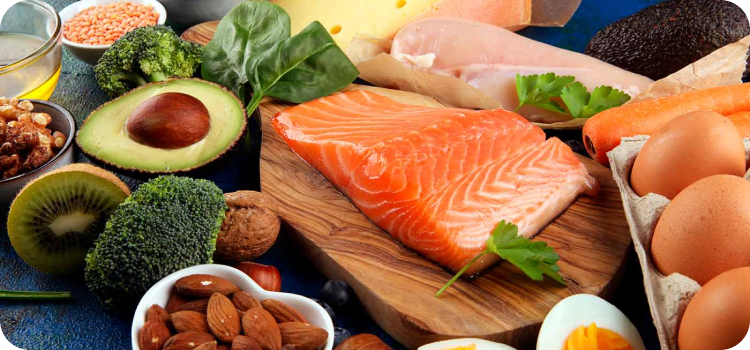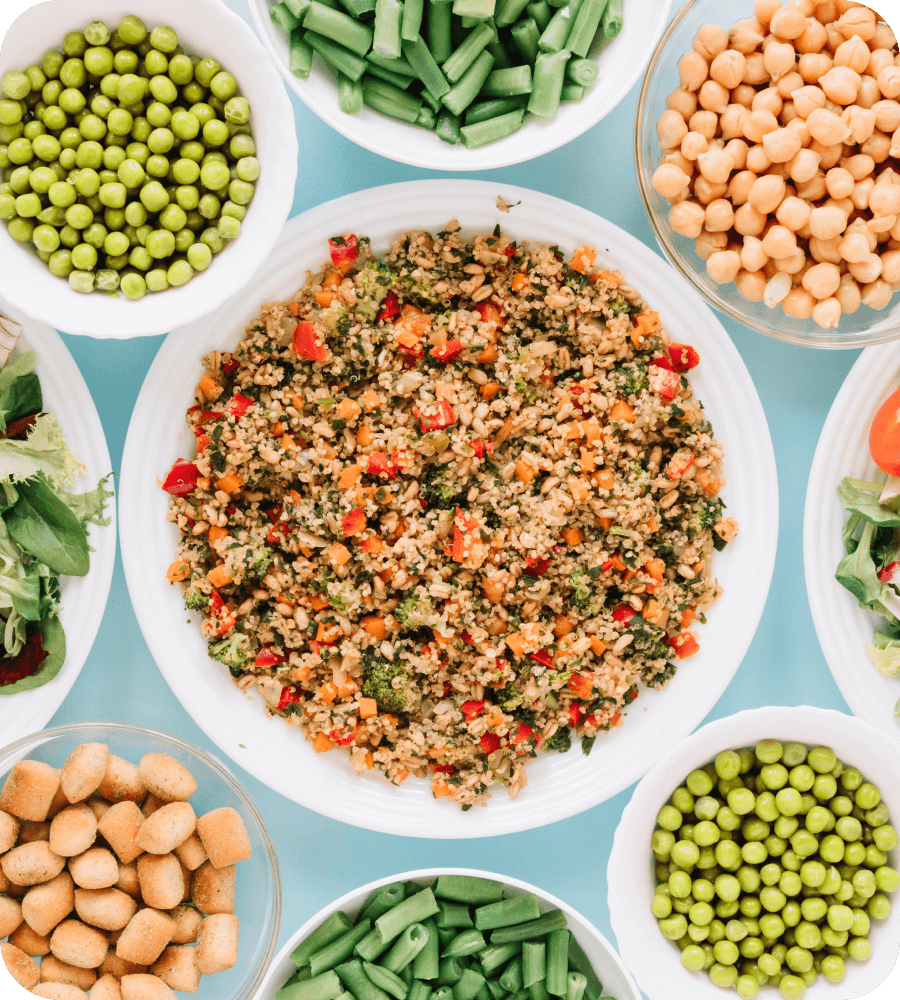Here are some practical tips on how to eat 200 grams of protein a day, along with plenty of mouthwatering meal ideas.
Key Takeways:
- The optimal daily protein intake varies depending on individual factors such as age, activity level, and fitness goals. Some people, especially bodybuilders, may need 200 grams of protein per day.
- To eat 200 grams of protein a day, plan your meals and snacks using a variety of protein sources. Add protein powder supplements when needed.
- Get meal suggestions for high-protein breakfast, lunch, dinner, and snacks, as well as, vegan substitutes for those following a plant-based diet.
High protein diets are popular among bodybuilders and weight loss enthusiasts alike. For bodybuilders, protein is the fuel that powers their muscle recovery and growth. It is the key ingredient to sculpting a powerful physique.
Going easy on your carb and calorie intake while increasing your protein consumption has significant weight loss benefits and your ability to maintain lean muscle mass while lowering body fat. It boosts your metabolism, suppresses appetite and food cravings, keeps you feeling full longer, and enhances fat burning.
However, protein is not just for fitness fanatics. It is the cornerstone of a balanced diet that fuels your body, repairs tissues, and supports your immune system.
Is 200 Grams of Protein a Day Too Much?


200 grams of protein may sound like a lot. If you are a serious bodybuilder, along with your strength workouts, you may need to consume about 150 to 200 grams of protein for serious muscle gains. Keep in mind that this varies from person to person.
How much protein do you need every day? - Harvard Health Publishing
Iraki J, Fitschen P, Espinar S, Helms E. Nutrition Recommendations for Bodybuilders in the Off-Season: A Narrative Review. Sports (Basel). 2019 Jun 26;7(7):154. doi: 10.3390/sports7070154. PMID: 31247944; PMCID: PMC6680710.
Wu G. Dietary protein intake and human health. Food Funct. 2016 Mar;7(3):1251-65. doi: 10.1039/c5fo01530h. PMID: 26797090.
To alleviate potential stress on the kidneys, it's important to drink plenty of fluids and stay hydrated. If weight gain is the concern, then you can rest assured that high-protein diets have been found to support weight management by boosting metabolism and increasing feelings of fullness.
How to Eat 200 Grams of Protein per Day?


First of all - what does 200g of protein look like?
A combination of 2 cups of cooked quinoa, 8oz grilled chicken breast, 400 grams of cottage cheese, 4 boiled eggs, and 400 ml of Greek yogurt has approximately 200 grams of protein, 130 grams of carbs, and 1600 calories.
That's an amazing amount of delicious and filling food for just 1600 calories!
This is just a sample of high-protein foods you can include in your daily diet to eat 200 grams of protein a day. You can add adequate amounts of fruits, vegetables, grains, and healthy fats to make your diet more balanced and healthy. Additionally, to sustain a high-protein diet, do not be afraid to incorporate protein shakes. When making your protein shake, we recommend plant-based protein powder, however some like whey protein powder a lot more. If you like eating a lot more, you can try a protein bar or other high-protein snacks.
Building Meals Around High Protein Intake
To meet your protein target for the day, you need to build your meals around protein. Here are 12 tips to help you out:
- Include protein in every meal: An early morning cup of protein coffee can kickstart your day. You can also opt for a glass of warm water with lemon, honey, and chia seeds. Include plenty of protein in your main meals of breakfast, lunch, and dinner. You can even have a protein shake before bed!
- Snack on protein: Snacks can significantly add to your daily protein intake. Snack on nuts, cheese, boiled eggs, chickpea salad, Greek yogurt, hummus with veggies, and so on to maximize your protein intake.
- Select high-protein foods: You can do this according to your dietary preferences. A combination of animal and plant-based sources is most convenient. Vegetarians can use dairy, legumes, and plant-based protein options to reach their protein target while vegans can rely on plant-based sources and supplements.
- Cook using protein-rich ingredients: While cooking, use as many protein-rich ingredients as possible. Scramble eggs with cottage cheese and bacon bits. Garnish with nuts and seeds. Add cooked chicken pieces and eggs to your lentil soups. Add nut butter, cashew nut paste, almond powder, etc. to your gravies to thicken them.
- Supplement with protein powder: Protein powder can help bridge the gaps to meet your protein targets. Add them to your meals, gravies, smoothies, and even cookies and pancakes.
- Balanced nutrition: For your main meals, only a quarter of your plate needs to be protein. Half of it can be filled with vegetables; the remaining quarter can be complex carbs such as quinoa or brown rice. This adds additional nutrients and fiber.
- Portion control: A serving of protein is about the size of your palm. That’s approximately 3 to 4 ounces of chicken or meat. Rather than attempting to eat too much at one go, spread it out in the form of multiple meals and snacks.
- Meal prep: Plan and prep your meals ahead of time to ensure you stay on track with your diet goals. You can cook large batches of protein once or twice a week. You can also store them in portion-sized containers or zip locks for easy access.
- Add healthy fats: Include healthy fats, such as olive oil, coconut milk, avocados, and, nuts, in your meals. This makes the food tastier and more filling.
- Incorporate variety: To get a wide range of nutrients and flavors, rotate between various types of protein, especially animal and plant-based proteins. Don't stick to just one protein source. This helps prevent diet monotony.
- Experiment with cooking methods: Keep your meals interesting and flavorful. Try sautéing, grilling, steaming, or baking your protein sources.
- Season creatively: To enjoy your meals to the fullest and stay on track with your goal of protein-rich meals, you must make these meals as delicious and attractive as possible. Use herbs, spices, and healthy sauces to enhance their flavor and aroma.
Best Breakfast Options
A protein-rich breakfast sets the tone for balanced nutrition and gives you the energy to get going. Here are some ideas to get your morning protein fix:
- Oatmeal with Greek Yogurt and Nuts: Mix your oatmeal with Greek yogurt, layer with fresh berries, drizzle honey, and top with chopped nuts. Sprinkle some granola for added crunch. You can also add a scoop of protein powder for extra protein.
- Scrambled Eggs with Spinach and Mushrooms: Sauté mushrooms and spinach before adding eggs and scrambling. Add diced tomatoes and seasonings of your choice. Serve with a sprinkle of feta cheese.
Best Lunch and Dinner Options For A High Protein Diet
Lunch and dinner play a crucial role in crafting meals to achieve your high protein targets. Here are some protein-rich meal ideas for lunch and dinner:
- Grilled Chicken Salad: chop up grilled chicken breast and layer on a base of leafy greens. Add chickpeas and a variety of colorful veggies. Drizzle olive oil dressing.
- Baked Salmon: Season salmon fillets with spices and herbs of your choice. Bake in the oven and serve with a cup of cooked quinoa and steamed broccoli for a nutritious and protein-packed meal.
- Tofu Stir-Fry: Stir fry tofu cubes with broccoli, bell peppers, and other veggies of your choice. Season with salt, pepper, vinegar, and soy sauce. Garnish with chopped nuts. Serve with a cup of brown rice.
Best Snacking Options
Consider these options if you are looking for protein-rich snacks:
- Nuts such as almonds, walnuts, cashews and peanuts
- Cottage cheese with fresh fruit or dried berries
- Hard-boiled eggs
- Greek yogurt with berries and nuts
- Hummus with veggies
- Peanut butter with sliced bananas or an apple
Protein-rich smoothies can also take the place of a snack or a pre/post-workout drink. You can even take it as a meal replacement drink. Blend fruits, nut butter, seeds, and greens with yogurt or a milk of your choice. This can be cow’s milk, coconut milk, almond, or soy milk. You can add some whey or plant-based protein powder to make it richer and creamier.


Sample Meal Plan
Here's a sample meal plan to help you reach your daily goal of 200 grams of protein.
Breakfast: 42 grams of protein
- 4 eggs scrambled (28g protein)
- 1/4 cup feta cheese (6g protein)
- 2 slices of whole-grain toast (8g protein)
Mid-Morning Snack: 21 grams of protein
- 1 cup of Greek yogurt and mixed berries: (15g protein)
- 1 oz almonds (6g protein)
Lunch: 42 grams of protein
- Grilled Chicken Salad with 6 ounces of grilled chicken breast (42g protein)
- Mixed greens, tomatoes, cucumbers, and bell peppers
- Olive oil and balsamic vinegar dressing.
Afternoon Snack: 33 grams of protein
- 1 cup cottage cheese
- 1 oz cashew nuts (5 grams)
Dinner: 64 grams of protein
- 8 ounces baked salmon: (48g protein)
- 1 cup quinoa: (8g protein)
- 1 cup steamed broccoli: (3g protein)
- 1 cup sautéed spinach: (5g protein)
The protein content of this adds up to approximately 202 grams.
Vegan Substitutes to Consume 200g Protein a Day


If you are a vegan, you can use this list of plant-based protein sources for your meal ideas and easily reach your protein goals:
- Tofu
- Quinoa
- Chickpeas
- Lentils
- Tempeh
- Seitan
- Beans such as black beans and kidney beans
- Plant-based protein powders such as pea protein and soy protein powders
You can make lentil or chickpea curry and serve with quinoa. Alternatively, you can make a quinoa salad with chickpeas and veggies. You can increase its protein content using a tahini-based dressing. The chickpeas can be used to make hummus. Use this as a dip or add them to salads.
You can marinate and grill tempeh or use it in sandwiches with whole wheat bread. Tofu and veggie stir-fry is another vegan favorite you must try.
Conclusion

Not everyone needs to eat 200 grams of protein a day. How much protein you need for achieving your health and fitness goals depends on personal factors. You can easily achieve your protein needs by using the practical tips and meal ideas outlined in this article. Remember to include diverse protein sources, practice portion control and stay hydrated.
 References
References 
- How much protein do you need every day? - Harvard Health Publishing
- Iraki J, Fitschen P, Espinar S, Helms E. Nutrition Recommendations for Bodybuilders in the Off-Season: A Narrative Review. Sports (Basel). 2019 Jun 26;7(7):154. doi: 10.3390/sports7070154. PMID: 31247944; PMCID: PMC6680710.
- Wu G. Dietary protein intake and human health. Food Funct. 2016 Mar;7(3):1251-65. doi: 10.1039/c5fo01530h. PMID: 26797090.





















